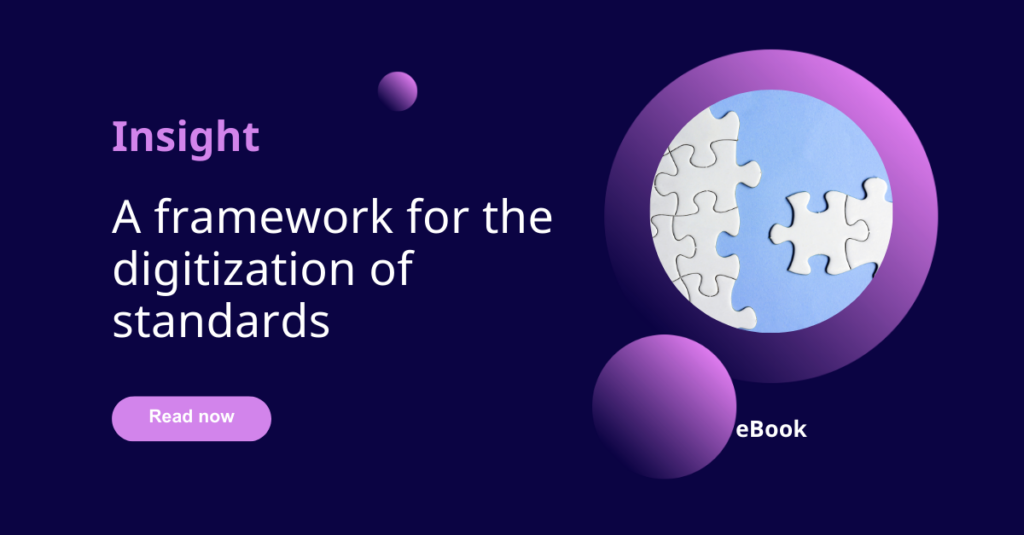Standards have always been foundational to industry and society. Historically, Standards Development Organizations (SDOs) have been the trusted custodians, guiding the creation and maintenance of standards. The landscape is evolving, largely driven by the rising influence of a particular consumer: machines.
Businesses whose operations depend on compliance with the latest standards are becoming increasingly digital. These organizations require more machine-readable formats and faster ways of actioning updates to standards. The need for machine-readable requirements has never been greater. This shift has accelerated the rise of industry-led data models.
The emergence of artificial intelligence (AI), notably Generative AI (Gen AI) adds a new layer of complexity. Gen AI can do more than create very good copies of standards; it can create commentaries and summaries, identify material changes and the impact of change.
This raises pivotal questions: What factors are key in considering the risks and opportunities related to Gen AI? And how might SDOs evolve their vital role in an increasingly digital world?
Rising demand for machine-readable requirements
Previous decades have seen a rising demand for more machine-readable standards that can be incorporated into increasingly digital workflows. Related challenges for standards consumers include:
- The sheer volume of standards across industries makes it increasingly difficult for organizations – especially those in highly regulated sectors – to locate the specific requirements they need.
- Rapid advancements, e.g. technological innovation, require up-to-date standards to be immediately available for organizations to stay competitive and compliant.
- As standards are increasingly adopted across borders, organizations often need to reference multiple standards that must work together.
This requires a shift towards enhanced discoverability on digital platforms, a need that Gen AI could help address by making standards easier to find and consume. However, addressing the underpinning information exchange between standards developers and consumers remains a challenge.
Initiatives to develop industry-led data models
Across industries, initiatives are emerging to develop standardized taxonomies to address these challenges. Examples include:
- Digital & Information Standards Subcommittee (DISC): A framework being developed by the International Association of Oil and Gas Producers
- Digital Standards Alliance (DSA): An initiative spearheaded by SAE ITC that aims to create machine-readable digital standards for the aviation industry
- Building Information Models (BIM): An initiative within the construction industry
- Digital Standards Initiative (DSI): An initiative of the International Chamber of Commerce’s aimed at accelerating the creation of a globally harmonized, digitized trade environment
This trend is a sign of what is to come, a sign of an ongoing shift across industries from documents to data. The arrival of Gen AI, however, means that this shift must become highly fine-grained.
Balancing disruption with innovation
Standards play a crucial role in establishing trustworthiness, especially in the context of the evolving technological landscape. Today’s citizens face sophisticated misinformation such as deepfakes.
Historically, physical media like paper, vellum, and stone have been utilized to determine the master version of legal documents. Each has two important factors:
1. Fixity
2. Longevity
Physical media also have greater longevity than many digital file types and digital media. One example is the Domesday Book – a manuscript record of the Great Survey of much of England and parts of Wales commissioned by William the Conqueror. Completed in 1086 AD, it is still legible today. The technology utilized as part of a major interactive project to develop a multimedia edition published in 1986 has already become obsolete.
Today, citizens carry out many aspects of their lives online from banking to government services. The importance of accurate digital records is growing rapidly with the rise of Gen AI in tandem with the rapidly advancing ability to create and duplicate digital files. There are a number of initiatives underway to safeguard electronic legal materials, including in the United States, the Uniform Electronic Legal Material Act (UELMA).
In this new landscape, the digital provenance of standards is essential, ensuring the authenticity, integrity, and traceability of digital materials and establishing trust at a time when citizens may lack certainty in the material they find online.
For some years, the conversation has centered on shifting from documents to data and this is still true however, now with the rise of AI, what goes along with this shift is a change from thinking about data structures in hierarchies to thinking about data structures as a way of establishing connections.
Preparing for AI-ready standards
There are well-publicized drawbacks related to AI that mean that security is a necessary consideration when implementing AI-ready standards. Such drawbacks include:
- Bias
- Trust
- Hallucinations
- Ethical concerns
- Data privacy
- Intellectual property protection
Two techniques are emerging to address AI-related challenges.
- Knowledge graphs encompass digital content of all forms, focusing on mapping out the interconnections between all component pieces. Knowledge graphs are a way of representing the links between pieces of data through citation networks.
- Retrieval Augmented Generation (RAG) is a method for enhancing the output of an LLM by integrating information from a reliable source outside of its training data before generating a response. It can also cross-reference internal information in its responses.
These techniques provide SDOs with a powerful paradigm for maximizing the value of Gen AI. However, it is essential to prepare systems and data for these critical next steps.
The shift from documents to data must be fine-grained
- Contextual relevance: Ensures standards are applied accurately in different scenarios
- Multi-faceted information sharing: Enhances richness and usability
- TimeArc® hyperlinking capabilities: Facilitates interconnected, digital-first information models
This approach also aligns with how businesses want to consume standards as user expectations for the kinds of experience they should have continue to evolve.
Turning disruption into opportunity
The arrival of AI marks a tipping point for standards developers. However, embracing AI also represents an opportunity. This is the moment for standards developers to reimagine their business models; it is the moment to reinforce the role of SDOs as trusted sources of information in an evolving digital ecosystem. It is time to act but it is not the moment for short-term solutions or quick fixes.
This strategic shift allows standards developers to operationalize requirements more efficiently, integrate them into AI systems, and create enhanced user experiences without compromising data control. The path forward is complex and fast-moving. Yet the message is clear: Standards need to become AI-ready. Those who adapt will lead the next generation of digital standardization.

